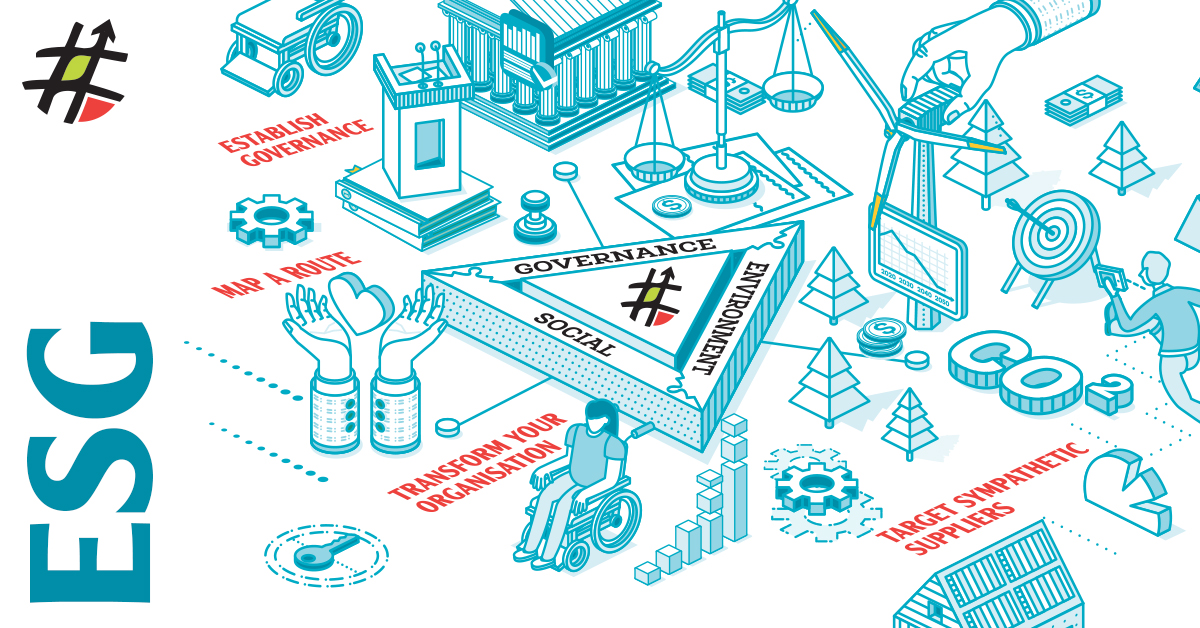ESG is the current buzz-acronym of the corporate world, but high inflation and supply chain disruptions have led many businesses to move their focus elsewhere. This is a mistake. It was once assumed that businesses had to make a choice between doing what was right and doing what was profitable. We now know that Environmental, Social and Governance policies are not only an inescapable part of running a modern business, they also have the potential to create serious value.
But how exactly is this achieved? Considering that 80% to 90% of a product’s greenhouse gas emissions are Scope 3 (a result of the supply chain), procurement has a big hand to play.
Below, we take you through a step-by-step process that your business can use to start their ESG journey (it is a journey, not a destination). First, though, let’s look at what ESG is and how we know it’s profitable.
What is ESG?
Environmental. Social. Governance.
- Environmental: broadly, this category is about your business’s carbon emissions and its impact on the environment. How can you cut waste and use your resources more efficiently?
- Social: this is about people, your customers, your reputation. Who do you do business with, and in what manner?
- Governance: controls, procedures, compliance. How do you govern yourself? Does it lead to effective decision making? Are you compliant with laws and regulations?
For the modern business, it’s easy to see how ESG is an inextricable part of everyday operations. Rather than seeing this as an annoyance, it needs to be seen for what it is: an opportunity.
ESG is good for business
We know ESG adds value. In 2019, McKinsey shared the results of more than 2,000 studies on the impact of ESG, 63% of which were positive findings and only 8% negative. Last year, their own analysis found that top ESG performers demonstrated faster growth and higher valuations than their competitors by as much as 20%.
So how does ESG lead to this?
- ESG forces companies to become more efficient and reduce waste. By improving manufacturing processes, acquiring better equipment, recycling and reusing, companies can drastically cut basic operational costs.
- Being adept in the ESG field keeps you ahead of ever-tightening government regulations. It also marks you as a trusted operator by the public sector, giving you access to new markets and the opportunity to expand.
- If you want the best and the brightest at your company, you have to provide a sense of purpose. The modern employee wants to be part of something positive, that has a demonstrably positive impact on the wider world. If you’re not embracing ESG, you’re not part of the future.
How to begin the ESG journey
60% of companies that want to be more sustainable admit to having no aligned strategy to achieve this. Quite simply, they don’t know where to begin. Here are your first steps.
- What is your current performance?
To get where you want to go, you have to know where you’re starting form. What processes do you currently have in place that allow you to identify risks and opportunities? What are your competitors doing?
- Map a route.
What functional objectives can be aligned with ESG goals? Put a plan in place for the next five years that clearly states the goals and ambition.
- Establish governance.
To achieve these goals, you need the right policies in place. This isn’t only about keeping in step with regulations, but satisfying customers and, yes, the public. The policies also need to make it clear how purchasing is meant to be conducted for ESG goals to be reached.
- Target sympathetic suppliers.
To improve the performance of your supply chain, you need to identify the vendors who will make the biggest difference and third parties that will help you monitor their performance. Also, which minority-owned SMEs can you incorporate into your supply chain? Do you have the specific knowledge needed to work with such companies?
- Transform your organisation.
To achieve success, these ESG goals need to be embedded in all strategic objectives, from category management to market analysis. Employees need to be in no doubt as to how serious the company is about these objectives. Progress must be tracked and shared with stakeholders.
Get the knowledge you need for a successful ESG journey
Aligning ESG policies with functional objectives takes experience and knowledge. Comprara’s Commercial Business Review is a comprehensive and exhaustive consultancy pathway that determines exactly how effective the policies and frameworks are that you have in place – including ESG. We can show you exactly where you are on your ESG journey and what steps you need to take.
Talk to Comprara today to start the journey.








